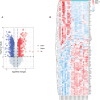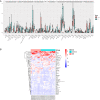Identification of Ribonuclease 6 as an immunoinflammatory key gene associated with the glomerular injury in diabetic nephropathy
- PMID: 36385487
- PMCID: PMC9668917
- DOI: 10.1038/s41598-022-24289-0
Identification of Ribonuclease 6 as an immunoinflammatory key gene associated with the glomerular injury in diabetic nephropathy
Abstract
Diabetic nephropathy is one of the major causes of end-stage renal disease, and the pathogenesis of the disease has not been elucidated. While the immunoinflammatory response plays an essential role in the progression of diabetic nephropathy. Glomerular expression dataset in diabetic nephropathy was obtained from the GEO database. Differentially expressed genes were identified and functional enrichment analysis was performed to find genes associated with immunity and inflammation from them. The hub genes of immunoinflammatory were identified using MCODE after establishing the PPI network and gene expression was verified with diabetic nephropathy model rats. Xcell was used to assign immune cells to diabetic nephropathy glomerular samples to detect significant changes in immune cells and to analyze correlations with the hub gene. We found 120 DEGs associated with immunity and inflammation, Ribonuclease 6 was the Hub gene with the highest MCODE score. Xcell analysis revealed significant changes of immune cells in DN glomeruli, including upregulated Activated DCs, Conventional DCs, CD4+ Tem, Epithelial cells, Macrophages, Macrophages M1, and Memory B-cells. RNase6 expression showed the highest positive correlation with Macrophages M1, Activated DCs, and Conventional DCs. We verified through the Nephroseq v5 database that RNase6 expression was elevated in DN glomeruli and negatively correlated with glomerular filtration rate. Animal studies revealed that the kidney of DN model rats showed increased RNase6 expression together with inflammatory factor TNF-alpha and chemokine MCP-1. Our study identified RNase6 as a diagnostic and prognostic biomarker for diabetic nephropathy and found that it may play an essential role in the immunoinflammatory damage to the glomerulus.
© 2022. The Author(s).
Conflict of interest statement
The authors declare no competing interests.
Figures








Similar articles
-
Identification of PDK4 as Hub Gene for Diabetic Nephropathy Using Co-Expression Network Analysis.Kidney Blood Press Res. 2023;48(1):522-534. doi: 10.1159/000531288. Epub 2023 Jun 29. Kidney Blood Press Res. 2023. PMID: 37385224 Free PMC article.
-
Identification and validation of key extracellular proteins as the potential biomarkers in diabetic nephropathy.Eur J Med Res. 2024 Oct 26;29(1):517. doi: 10.1186/s40001-024-02120-y. Eur J Med Res. 2024. PMID: 39456069 Free PMC article.
-
GBP2 promotes M1 macrophage polarization by activating the notch1 signaling pathway in diabetic nephropathy.Front Immunol. 2023 Aug 9;14:1127612. doi: 10.3389/fimmu.2023.1127612. eCollection 2023. Front Immunol. 2023. PMID: 37622120 Free PMC article.
-
Role of Dendritic Cell in Diabetic Nephropathy.Int J Mol Sci. 2021 Jul 14;22(14):7554. doi: 10.3390/ijms22147554. Int J Mol Sci. 2021. PMID: 34299173 Free PMC article. Review.
-
The Role of Chemokines and Chemokine Receptors in Diabetic Nephropathy.Int J Mol Sci. 2020 Apr 30;21(9):3172. doi: 10.3390/ijms21093172. Int J Mol Sci. 2020. PMID: 32365893 Free PMC article. Review.
Cited by
-
Early use of SGLT2 inhibitors reduces the progression of diabetic kidney disease: a retrospective cohort study.Am J Transl Res. 2024 Sep 15;16(9):4967-4978. doi: 10.62347/ARYA8831. eCollection 2024. Am J Transl Res. 2024. PMID: 39398587 Free PMC article.
-
Higher density of CD4+ T cell infiltration predicts severe renal lesions and renal function decline in patients with diabetic nephropathy.Front Immunol. 2024 Nov 25;15:1474377. doi: 10.3389/fimmu.2024.1474377. eCollection 2024. Front Immunol. 2024. PMID: 39654881 Free PMC article.
-
scRNA-Seq and Bulk-Seq Analysis Identifies S100A9 Plasma Cells as a Potentially Effective Immunotherapeutic Agent for Multiple Myeloma.J Inflamm Res. 2024 Mar 9;17:1527-1548. doi: 10.2147/JIR.S452062. eCollection 2024. J Inflamm Res. 2024. PMID: 38481477 Free PMC article.
References
Publication types
MeSH terms
Substances
Grants and funding
LinkOut - more resources
Full Text Sources
Medical
Research Materials
Miscellaneous

